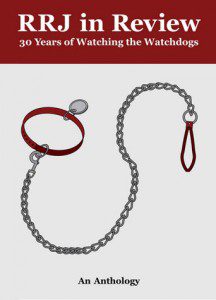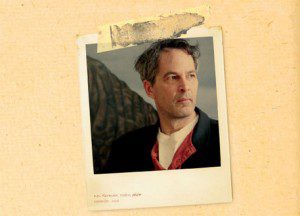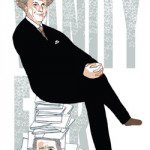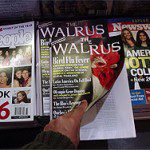Into the Wild
An incredible journey deep into the heart of Walrus country
In its premiere issue almost four years ago, The Walrus magazine introduced a front section called Field Notes. Its purpose: to offer Canadian readers a peek into indigenous cultures abroad. In scientific circles, the term refers to the notes taken by scientists during or after their observations of the phenomena they are studying. These types of field notes are a description of events, interviews, beliefs and personal reactions to what the scientist sees around her. With this as a guiding premise, the Ryerson Review of Journalism decided to observe up close the comings and goings, the rituals and rivalries and the hunt for sustenance of what is in Canada, a strange publishing animal. What follows is the result of six months of close observation and investigation into this lumbering beast that, like its namesake, has been teetering on the edge of extinction for much of its life.
SIGHTING
Walrus editor Ken Alexander and the magazine’s new publisher Shelley Ambrose
LOCATION
Downtown Toronto, the inaugural “Wild and Wonderful Walrus Party”
DAY AND TIME
November 22, 2006, 7 p.m. to midnight
The din of conversation seldom lets up. At the centre of the crowded lobby of Toronto’s Isabel Bader Theatre is the wild (to some) and wonderful (to others) Ken Alexander, boss walrus. Unlike in the Arctic ice floes, where the dominant walrus displays the longest tusks – up to one metre – Alexander proves he is the boss by a human display of power: He and his herd, particularly the family foundation, have thus far been the prime source of funds for The Walrus. Charming and bright, wearing a pewter suit, he is, tonight, a striking contrast to the Alexander found in his offices. There, he is overworked, under-slept, eccentric and the object of much gossip, some of it bitter. Here, he is smooth and collected, the noble champion of Canada’s only mainstream, national magazine of long-form journalism devoted to ideas, culture and current affairs. He plays the part perfectly.
Glass of white wine in hand, Alexander’s voice booms as he speaks to an interchanging circle of people. Two lines manoeuvre slowly around him: one flows toward the huddle of velvet, lace and pressed shirts at the free wine table; the other moves away from it, leaving behind a trail of empty glasses and stained tablecloths. This is the first stage of the night’s three-part fundraiser. Later, inside the theatre, the 450 supporters, who each paid either $125 (subscribers to the magazine) or $150 (nonsubscribers) to be there, will see part two conclude with a public discussion on optimism by designer Bruce Mau and Alexander. Given the Walrus’s tumultuous past, it’s a word Alexander does well to know.
After an hour of mingling and an hour and a half of intellectual entertainment, the Wild and Wonderful Walrus Party moves around the corner to stage three: “fine food and dancing” at the Gardiner Museum, home to a collection of ceramics as fragile as the egos of many writers after encountering the wild Alexander. At the Gardiner, servers dressed like swanky hotdog vendors navigate the throng, handing out gourmet fries and onion rings in oily paper cones. It’s like a souped-up greasy spoon. No one is dancing. Alexander exchanges his glass of wine for a pint. Next to him is Shelley Ambrose, the magazine’s newly hired publisher and executive director of The Walrus Foundation, to which the modest $30,000 raised at this event will go. There are whispers throughout the magazine industry that she, if successful in her new dual role, could soon grow tusks long enough to vie for dominance.
Right now the two are friendly and animated as they speak to members of another ever-shifting circle that includes, at times, Walrus-ites such as Nora Underwood and Daniel Baird and freelancers such as Marci McDonald, who wrote the cover story for the magazine’s first issue, an award-winning 12,000-word investigative piece on the business dealings of then prime minister Paul Martin.
This is the first significant fundraising event the foundation has held since it won charitable status from the Canada Revenue Agency (CRA) after a three-year struggle. At the time, the November 2005 success prompted much celebration. Finally, everybody hoped, the magazine could move forward and begin its long-desired appeal for funds from foundations and other interested parties. But what came instead was a year-long fundraising standstill, one that prompted many to criticize the foundation for wasting a year.
On this night, though, nobody wants to breach the camaraderie to dwell on the animosity that has plagued the Walrus and Alexander. This fundraiser, planned long before Ambrose signed on, is all about signalling to staff, contributors, supporters, potential supporters, suppliers and numerous others that it’s time to forget the past and move on to the next stage in the evolution of the Walrus.
But the story of how the magazine survived until now is just as compelling – perhaps more so – as the tale of where it’s going. The three years leading to this party were an incredible journey that would have felled a less determined species. But that struggle for survival, as remarkable as it is, also raises questions about the revolving door of staffers, freelancers and board members, the constant search for cash and the quest for charitable status that began before the first issue came out. The questions include: Why did so many people leave the Walrus? How exactly was the beast funded for three years without charitable status? How hard is it, really, to work for the Walrus? How, after being rejected more than once, did the Walrus finally win charitable status? What concessions did it make to satisfy the CRA – and are they nothing but a sham? Central to it all is the man who has been castigated so frequently: the Wild and Wonderful Ken Alexander.
To read the rest of this story, please see our ebook anthology: RRJ in Review: 30 Years of Watching the Watchdogs.
It can be purchased online here.















